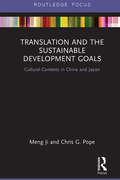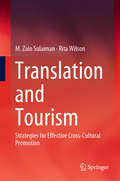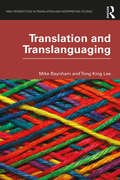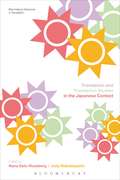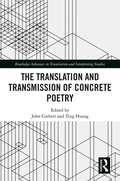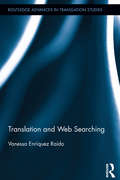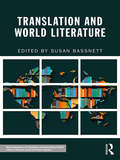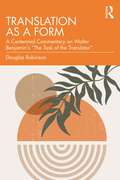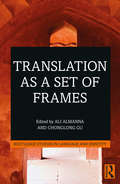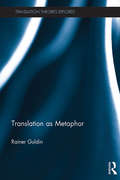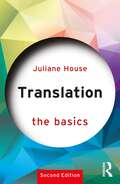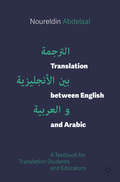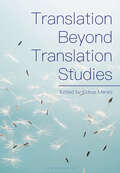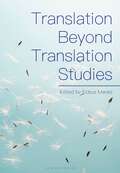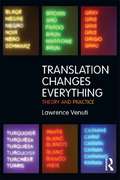- Table View
- List View
Translation and the Sustainable Development Goals: Cultural Contexts in China and Japan (Routledge Focus on Public Governance in Asia)
by Meng Ji Chris G. PopeThis book offers insight into the use of empirical diffusionist models for analysis of cross-cultural and cross-national communication, translation and adaptation of the United Nation’s (UN) Sustainable Development Goals (SDGs). The book looks at three social analytical instruments of particular utility for the cross-national study of the translation and diffusion of global sustainable development discourses in East Asia (China and Japan). It explains the underlying hypothesis that, in the transmission and adaptation of global SDGs in different national contexts, three large groups of social actors encompassing sources of information, mediating actors and socio-industrial end-users form, shape and contribute to the complex, latent networks of social engagement. It illuminates how the distribution within these networks largely determines the level and breadth of the diffusion of global SDGs and their associated environmentalist norms. This book is an essential read for anyone interested in sustainable growth and development, as well as global environmental politics.
Translation and Tourism: Strategies for Effective Cross-Cultural Promotion
by Rita Wilson M. Zain SulaimanThis book addresses one of the most central, yet criticised, solutions for international tourism promotion, namely translation. It brings together theory and practice, explores the various challenges involved in translating tourism promotional materials (TPMs), and puts forward a sustainable solution capable of achieving maximum impact in the industry and society.The solution, in the form of a Cultural-Conceptual Translation (CCT) model, identifies effective translation strategies and offers a platform for making TPM translation more streamlined, efficient and easily communicated. Using the English-Malay language combination as a case study, the book analyses tourism discourse and includes a road test of the CCT model on actual end-users of TPMs as well as tourism marketers in the industry. Guidelines for best practices in the industry round out the book, which offers valuable insights not only for researchers but also, and more importantly, various stakeholders in the translation, tourism and advertising industries.
Translation and Translanguaging (New Perspectives in Translation and Interpreting Studies)
by Mike Baynham Tong King LeeTranslation and Translanguaging brings into dialogue translanguaging as a theoretical lens and translation as an applied practice. This book is the first to ask: what can translanguaging tell us about translation and what can translation tell us about translanguaging? Translanguaging originated as a term to characterize bilingual and multilingual repertoires. This book extends the linguistic focus to consider translanguaging and translation in tandem – across languages, language varieties, registers, and discourses, and in a diverse range of contexts: everyday multilingual settings involving community interpreting and cultural brokering, embodied interaction in sports, text-based commodities, and multimodal experimental poetics. Characterizing translanguaging as the deployment of a spectrum of semiotic resources, the book illustrates how perspectives from translation can enrich our understanding of translanguaging, and how translanguaging, with its notions of repertoire and the "moment", can contribute to a practice-based account of translation. Illustrated with examples from a range of languages, including Spanish, Chinese, Japanese, Czech, Lingala, and varieties of English, this timely book will be essential reading for researchers and graduate students in sociolinguistics, translation studies, multimodal studies, applied linguistics, and related areas.
Translation and Translanguaging (New Perspectives in Translation and Interpreting Studies)
by Mike Baynham Tong King LeeTranslation and Translanguaging brings into dialogue translanguaging as a theoretical lens and translation as an applied practice. This book is the first to ask: what can translanguaging tell us about translation and what can translation tell us about translanguaging? Translanguaging originated as a term to characterize bilingual and multilingual repertoires. This book extends the linguistic focus to consider translanguaging and translation in tandem – across languages, language varieties, registers, and discourses, and in a diverse range of contexts: everyday multilingual settings involving community interpreting and cultural brokering, embodied interaction in sports, text-based commodities, and multimodal experimental poetics. Characterizing translanguaging as the deployment of a spectrum of semiotic resources, the book illustrates how perspectives from translation can enrich our understanding of translanguaging, and how translanguaging, with its notions of repertoire and the "moment", can contribute to a practice-based account of translation. Illustrated with examples from a range of languages, including Spanish, Chinese, Japanese, Czech, Lingala, and varieties of English, this timely book will be essential reading for researchers and graduate students in sociolinguistics, translation studies, multimodal studies, applied linguistics, and related areas.
Translation and Translation Studies in the Japanese Context (Continuum Advances in Translation)
by Nana Sato-Rossberg Judy WakabayashiJapan is often regarded as a 'culture of translation'. Oral and written translation has played a vital role in Japan over the centuries and led to a formidable body of thinking and research. This is rooted in a context about which little information has been available outside of Japan in the past. The chapters examine the current state of translation studies as an academic discipline in Japan and a range of historical aspects (for example, translation of Chinese vernacular novels in early modern times, the role of translation in Japan's modernization, changes in stylistic norms in Meiji-period translations, 'thick translation' of indigenous Ainu place names), as well as creative aspects of translation in modern and postwar Japan. Other chapters explore contemporary phenomena such as the intralingual translation of Japanese expressions embedded in English texts emanating from diasporic contexts, the practice of pre-translation or writing for an international audience from the outset, the innovative practice of reverse localization of Japanese video games back into Japanese, and community interpreting practices and research.
Translation and Translation Studies in the Japanese Context (Continuum Advances in Translation)
by Nana Sato-Rossberg Judy WakabayashiJapan is often regarded as a 'culture of translation'. Oral and written translation has played a vital role in Japan over the centuries and led to a formidable body of thinking and research. This is rooted in a context about which little information has been available outside of Japan in the past. The chapters examine the current state of translation studies as an academic discipline in Japan and a range of historical aspects (for example, translation of Chinese vernacular novels in early modern times, the role of translation in Japan's modernization, changes in stylistic norms in Meiji-period translations, 'thick translation' of indigenous Ainu place names), as well as creative aspects of translation in modern and postwar Japan. Other chapters explore contemporary phenomena such as the intralingual translation of Japanese expressions embedded in English texts emanating from diasporic contexts, the practice of pre-translation or writing for an international audience from the outset, the innovative practice of reverse localization of Japanese video games back into Japanese, and community interpreting practices and research.
The Translation and Transmission of Concrete Poetry: Translation and Transmission (Routledge Advances in Translation and Interpreting Studies)
by John Corbett Ting HuangThis volume addresses the global reception of "untranslatable" concrete poetry. Featuring contributions from an international group of literary and translation scholars and practitioners, working across a variety of languages, the book views the development of the international concrete poetry movement through the lens of "transcreation", that is, the informed, creative response to the translation of playful, enigmatic, visual texts. Contributions range in subject matter from ancient Greek and Chinese pattern poems to modernist concrete poems from the Americas, Europe and Asia. This challenging body of experimental work offers creative challenges and opportunities to literary translators and unique pleasures to the sympathetic reader. Highlighting the ways in which literary influence is mapped across languages and borders, this volume will be of interest to students and scholars of experimental poetry, translation studies and comparative literature.
The Translation and Transmission of Concrete Poetry: Translation and Transmission (Routledge Advances in Translation and Interpreting Studies)
by John Corbett Ting HuangThis volume addresses the global reception of "untranslatable" concrete poetry. Featuring contributions from an international group of literary and translation scholars and practitioners, working across a variety of languages, the book views the development of the international concrete poetry movement through the lens of "transcreation", that is, the informed, creative response to the translation of playful, enigmatic, visual texts. Contributions range in subject matter from ancient Greek and Chinese pattern poems to modernist concrete poems from the Americas, Europe and Asia. This challenging body of experimental work offers creative challenges and opportunities to literary translators and unique pleasures to the sympathetic reader. Highlighting the ways in which literary influence is mapped across languages and borders, this volume will be of interest to students and scholars of experimental poetry, translation studies and comparative literature.
Translation and Web Searching (Routledge Advances in Translation and Interpreting Studies)
by Vanessa Enríquez RaídoThe book presents a comprehensive study of various cognitive and affective aspects of web searching for translation problem solving. Research into the use of the web as an external aid of consultation has frequently occupied a secondary position in the investigation of translation processes. The book aims to bridge this gap in the literature. Beginning with a detailed survey of previous studies of these processes, it then focuses on web search behaviors using qualitative and quantitative analysis that presents a multifaceted overview of translation-oriented web searching. The book concludes by addressing the implications for the teaching of and research into translators’ web searching skills. With regard to teaching, the book's didactic discussions will make it a valuable tool for both translator trainers and translation students wanting to familiarize themselves with the intricacies of Web searching and to reflect upon the pedagogical implications of the study for acquiring online information literacy in translator training.
Translation and Web Searching (Routledge Advances in Translation and Interpreting Studies)
by Vanessa Enríquez RaídoThe book presents a comprehensive study of various cognitive and affective aspects of web searching for translation problem solving. Research into the use of the web as an external aid of consultation has frequently occupied a secondary position in the investigation of translation processes. The book aims to bridge this gap in the literature. Beginning with a detailed survey of previous studies of these processes, it then focuses on web search behaviors using qualitative and quantitative analysis that presents a multifaceted overview of translation-oriented web searching. The book concludes by addressing the implications for the teaching of and research into translators’ web searching skills. With regard to teaching, the book's didactic discussions will make it a valuable tool for both translator trainers and translation students wanting to familiarize themselves with the intricacies of Web searching and to reflect upon the pedagogical implications of the study for acquiring online information literacy in translator training.
Translation and World Literature (New Perspectives in Translation and Interpreting Studies)
by Susan BassnettTranslation and World Literature offers a variety of international perspectives on the complex role of translation in the dissemination of literatures around the world. Eleven chapters written by multilingual scholars explore issues and themes as diverse as the geopolitics of translation, cosmopolitanism, changing media environments and transdisciplinarity. This book locates translation firmly within current debates about the transcultural movements of texts and challenges the hegemony of English in world literature. Translation and World Literature is an indispensable resource for students and scholars working in the fields of translation studies, comparative literature and world literature.
Translation and World Literature (New Perspectives in Translation and Interpreting Studies)
by Susan BassnettTranslation and World Literature offers a variety of international perspectives on the complex role of translation in the dissemination of literatures around the world. Eleven chapters written by multilingual scholars explore issues and themes as diverse as the geopolitics of translation, cosmopolitanism, changing media environments and transdisciplinarity. This book locates translation firmly within current debates about the transcultural movements of texts and challenges the hegemony of English in world literature. Translation and World Literature is an indispensable resource for students and scholars working in the fields of translation studies, comparative literature and world literature.
Translation as a Form: A Centennial Commentary on Walter Benjamin’s “The Task of the Translator”
by Douglas RobinsonThis is a book-length commentary on Walter Benjamin’s 1923 essay "Die Aufgabe des Übersetzers," best known in English under the title "The Task of the Translator." Benjamin’s essay is at once an immensely attractive work for top-flight theorists of translation and comparative literature and a frustratingly cryptic work that cries out for commentary. Almost every one of the claims he makes in it seems wildly counterintuitive, because he articulates none of the background support that would help readers place it in larger literary-historical contexts: Jewish mystical traditions from Philo Judaeus’s Logos-based Neoplatonism to thirteenth-century Lurianic Kabbalah; Romantic and post-Romantic esotericisms from Novalis and the Schlegels to Hölderlin and Goethe; modernist avant-garde foreclosures on "the public" and generally the communicative contexts of literature. The book is divided into 78 passages, from one to a few sentences in length. Each of the passages becomes its own commentarial unit, consisting of a Benjaminian interlinear box, a paraphrase, a commentary, and a list of other commentators who have engaged the specific passage in question. Because the passages cover the entire text of the essay in sequence, reading straight through the book provides the reader with an augmented experience of reading the essay. Robinson’s commentary is key reading for scholars and postgraduate students of translation, comparative literature, and critical theory.
Translation as a Form: A Centennial Commentary on Walter Benjamin’s “The Task of the Translator”
by Douglas RobinsonThis is a book-length commentary on Walter Benjamin’s 1923 essay "Die Aufgabe des Übersetzers," best known in English under the title "The Task of the Translator." Benjamin’s essay is at once an immensely attractive work for top-flight theorists of translation and comparative literature and a frustratingly cryptic work that cries out for commentary. Almost every one of the claims he makes in it seems wildly counterintuitive, because he articulates none of the background support that would help readers place it in larger literary-historical contexts: Jewish mystical traditions from Philo Judaeus’s Logos-based Neoplatonism to thirteenth-century Lurianic Kabbalah; Romantic and post-Romantic esotericisms from Novalis and the Schlegels to Hölderlin and Goethe; modernist avant-garde foreclosures on "the public" and generally the communicative contexts of literature. The book is divided into 78 passages, from one to a few sentences in length. Each of the passages becomes its own commentarial unit, consisting of a Benjaminian interlinear box, a paraphrase, a commentary, and a list of other commentators who have engaged the specific passage in question. Because the passages cover the entire text of the essay in sequence, reading straight through the book provides the reader with an augmented experience of reading the essay. Robinson’s commentary is key reading for scholars and postgraduate students of translation, comparative literature, and critical theory.
Translation as a Set of Frames (Routledge Studies in Language and Identity)
by Ali Almanna; Chonglong GuEnvisioned as a much needed celebration of the massive strides made in translation and interpreting studies, this eclectic volume takes stock of the latest cutting-edge research that exemplifies how translation and interpreting might interact with such topics as power, ideological discourse, representation, hegemony and identity. In this exciting volume, we have articles from different language combinations (e.g. Arabic, English, Hungarian and Chinese) and from a wide range of sociopolitical, cultural, and institutional contexts and geographical locales (China, Iran, Malaysia, Russia and Nigeria). Those chapters also draw on a diverse range of theoretical perspectives and methodological approaches (e.g. critical discourse analysis, Bourdieu’s sociological theories, corpus linguistics, narrative theory and structuration theory), focusing on translation and interpreting relating to various settings and specialised genres (traditional media, digital media, subtitling, manga, etc.). As such, this volume serves as a dynamic forum for intercultural and interlingual communication and an exciting arena for interdisciplinary dialogues, thus enabling us to look beyond the traditionally more static, mechanical and linguistics-oriented views of translation and interpreting. This book appeals to scholars and students interested in translation and interpreting studies and issues of power, ideology, identity in interlingual and intercultural communication.
Translation as a Set of Frames (Routledge Studies in Language and Identity)
by Ali Almanna Chonglong GuEnvisioned as a much needed celebration of the massive strides made in translation and interpreting studies, this eclectic volume takes stock of the latest cutting-edge research that exemplifies how translation and interpreting might interact with such topics as power, ideological discourse, representation, hegemony and identity. In this exciting volume, we have articles from different language combinations (e.g. Arabic, English, Hungarian and Chinese) and from a wide range of sociopolitical, cultural, and institutional contexts and geographical locales (China, Iran, Malaysia, Russia and Nigeria). Those chapters also draw on a diverse range of theoretical perspectives and methodological approaches (e.g. critical discourse analysis, Bourdieu’s sociological theories, corpus linguistics, narrative theory and structuration theory), focusing on translation and interpreting relating to various settings and specialised genres (traditional media, digital media, subtitling, manga, etc.). As such, this volume serves as a dynamic forum for intercultural and interlingual communication and an exciting arena for interdisciplinary dialogues, thus enabling us to look beyond the traditionally more static, mechanical and linguistics-oriented views of translation and interpreting. This book appeals to scholars and students interested in translation and interpreting studies and issues of power, ideology, identity in interlingual and intercultural communication.
Translation as Metaphor (Translation Theories Explored)
by Rainer GuldinIn today’s ever-changing climate of disintegration and recombination, translation has become one of the essential metaphors, if not the metaphor, of our globalized world. Translation and Metaphor is an attempt to draw a comprehensive map of these new overlapping theoretical territories and the many cross-disciplinary movements they imply. In five chapters, this book examines: · The main metaphor theories developed in the West. · The way the notion of metaphor relates to the concept of translation. · Different theoretical perspectives on metaphors of translation in translation studies. · The main metaphors developed to describe translation in the West and in the East. · Spatial metaphors within translation studies, cultural studies and postcolonial theory. · The use of the metaphor of translation across psychoanalysis, anthropology and ethnography, postcolonial theory, history and literature, sociology, media and communication theory, and medicine and genetics. Comprehensive analysis of key metaphor theories, revealing examples from a wide range of sources and a look towards future directions make this is a must-have book for students, researchers and translators working in the areas of translation and translation theory.
Translation as Metaphor (Translation Theories Explored)
by Rainer GuldinIn today’s ever-changing climate of disintegration and recombination, translation has become one of the essential metaphors, if not the metaphor, of our globalized world. Translation and Metaphor is an attempt to draw a comprehensive map of these new overlapping theoretical territories and the many cross-disciplinary movements they imply. In five chapters, this book examines: · The main metaphor theories developed in the West. · The way the notion of metaphor relates to the concept of translation. · Different theoretical perspectives on metaphors of translation in translation studies. · The main metaphors developed to describe translation in the West and in the East. · Spatial metaphors within translation studies, cultural studies and postcolonial theory. · The use of the metaphor of translation across psychoanalysis, anthropology and ethnography, postcolonial theory, history and literature, sociology, media and communication theory, and medicine and genetics. Comprehensive analysis of key metaphor theories, revealing examples from a wide range of sources and a look towards future directions make this is a must-have book for students, researchers and translators working in the areas of translation and translation theory.
Translation: The Basics (The Basics)
by Juliane HouseTranslation: The Basics is an accessible and comprehensive introduction to the study of translation. This revised edition includes two new chapters on culturally embedded concepts and translation in global business. All references have been updated with additional references and new quotes added. Combining traditional text-based views with the context of translation in its widest sense, it presents an integrated approach to methodology in order to critically address influences such as power and gender, as well as cultural, ethical, political and ideological issues. This book answers such questions as: How can translations be approached? Do social issues and culture play a part in translations? How does a translation relate to the original work? What effect has globalization had on translation? What are the core concerns of professional translators? Key theoretical issues are explained with reference to a range of case studies, suggestions for further reading and a detailed glossary of terms, making this the essential guide for anyone studying translation and translation studies.
Translation: The Basics (The Basics)
by Juliane HouseTranslation: The Basics is an accessible and comprehensive introduction to the study of translation. This revised edition includes two new chapters on culturally embedded concepts and translation in global business. All references have been updated with additional references and new quotes added. Combining traditional text-based views with the context of translation in its widest sense, it presents an integrated approach to methodology in order to critically address influences such as power and gender, as well as cultural, ethical, political and ideological issues. This book answers such questions as: How can translations be approached? Do social issues and culture play a part in translations? How does a translation relate to the original work? What effect has globalization had on translation? What are the core concerns of professional translators? Key theoretical issues are explained with reference to a range of case studies, suggestions for further reading and a detailed glossary of terms, making this the essential guide for anyone studying translation and translation studies.
Translation between English and Arabic: A Textbook for Translation Students and Educators
by Noureldin AbdelaalThis textbook provides a comprehensive resource for translation students and educators embarking on the challenge of translating into and out of English and Arabic. Combining a solid basis in translation theory with examples drawn from real texts including the Qu’ran, the author introduces a number of the problems and practical considerations which arise during translation between English and Arabic, equipping readers with the skills to recognise and address these issues in their own work through practical exercises. Among these considerations are grammatical, semantic, lexical and cultural problems, collocations, idioms and fixed expressions. With its coverage of essential topics including culturally-bound terms and differences, both novice and more experienced translators will find this book useful in the development of their translation practice.
Translation Beyond Translation Studies
by Kobus MaraisWhat is 'translation'? Even as the scholarly viewpoint of translation studies has expanded over recent years, the notion of 'translation' has remained fixedly defined by its interlinguistic element. However, there are many different contexts and disciplines in which translation takes place for which this definition is entirely unsuitable.Exploring translational aspects in contexts in which scholars do not think about 'translation', this book considers the alternative uses of the term beyond the interlinguistic dimension. Taking our understanding of 'translation' back to its basic semiotic principles, leading experts outline the wide variety of alternative fields of study, practices, applications and contexts in which the term 'translation' is used. Chapters examine 11 different fields of study, exploring what the term 'translation' means, how it is used and what it could contribute to an enlarged understanding of 'translation' as a concept.In this way, the volume argues for a reimagining of what we mean by translation, providing an essential reference for anyone interested in how translation is understood and practiced beyond the narrow perspectives of the field of translation studies itself.
Translation Beyond Translation Studies
What is 'translation'? Even as the scholarly viewpoint of translation studies has expanded over recent years, the notion of 'translation' has remained fixedly defined by its interlinguistic element. However, there are many different contexts and disciplines in which translation takes place for which this definition is entirely unsuitable.Exploring translational aspects in contexts in which scholars do not think about 'translation', this book considers the alternative uses of the term beyond the interlinguistic dimension. Taking our understanding of 'translation' back to its basic semiotic principles, leading experts outline the wide variety of alternative fields of study, practices, applications and contexts in which the term 'translation' is used. Chapters examine 11 different fields of study, exploring what the term 'translation' means, how it is used and what it could contribute to an enlarged understanding of 'translation' as a concept.In this way, the volume argues for a reimagining of what we mean by translation, providing an essential reference for anyone interested in how translation is understood and practiced beyond the narrow perspectives of the field of translation studies itself.
Translation Changes Everything: Theory and Practice
by Lawrence VenutiIn Translation Changes Everything leading theorist Lawrence Venuti gathers fourteen of his incisive essays since 2000. The selection sketches the trajectory of his thinking about translation while engaging with the main trends in research and commentary. The issues covered include basic concepts like equivalence, retranslation, and reader reception; sociological topics like the impact of translations in the academy and the global cultural economy; and philosophical problems such as the translator’s unconscious and translation ethics. Every essay presents case studies that include Venuti’s own translation projects, illuminating the connections between theoretical concepts and verbal choices. The texts, drawn from a broad variety of languages, are both humanistic and pragmatic, encompassing such forms as poems and novels, religious and philosophical works, travel guidebooks and advertisements. The discussions all explore practical applications, whether writing, publishing, reviewing, teaching or studying translations. Venuti’s aim is to conceive of translation as an interpretive act with far-reaching social effects, at once enabled and constrained by specific cultural situations. This latest chapter in his developing work is essential reading for translators and students of translation alike.
Translation Changes Everything: Theory and Practice
by Lawrence VenutiIn Translation Changes Everything leading theorist Lawrence Venuti gathers fourteen of his incisive essays since 2000. The selection sketches the trajectory of his thinking about translation while engaging with the main trends in research and commentary. The issues covered include basic concepts like equivalence, retranslation, and reader reception; sociological topics like the impact of translations in the academy and the global cultural economy; and philosophical problems such as the translator’s unconscious and translation ethics. Every essay presents case studies that include Venuti’s own translation projects, illuminating the connections between theoretical concepts and verbal choices. The texts, drawn from a broad variety of languages, are both humanistic and pragmatic, encompassing such forms as poems and novels, religious and philosophical works, travel guidebooks and advertisements. The discussions all explore practical applications, whether writing, publishing, reviewing, teaching or studying translations. Venuti’s aim is to conceive of translation as an interpretive act with far-reaching social effects, at once enabled and constrained by specific cultural situations. This latest chapter in his developing work is essential reading for translators and students of translation alike.
